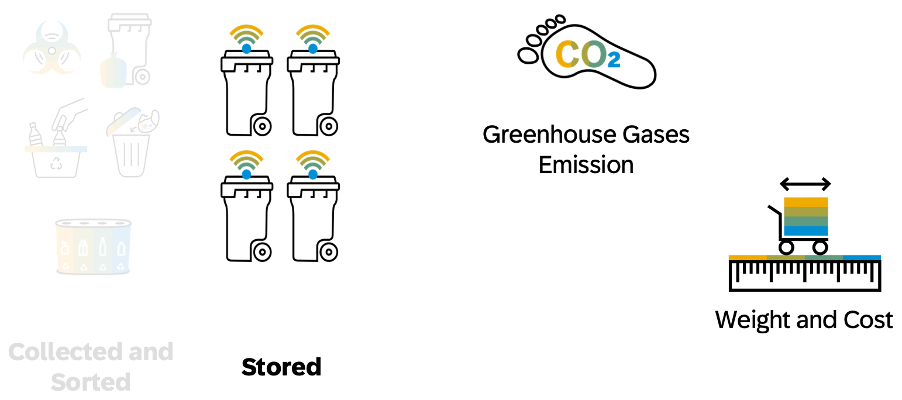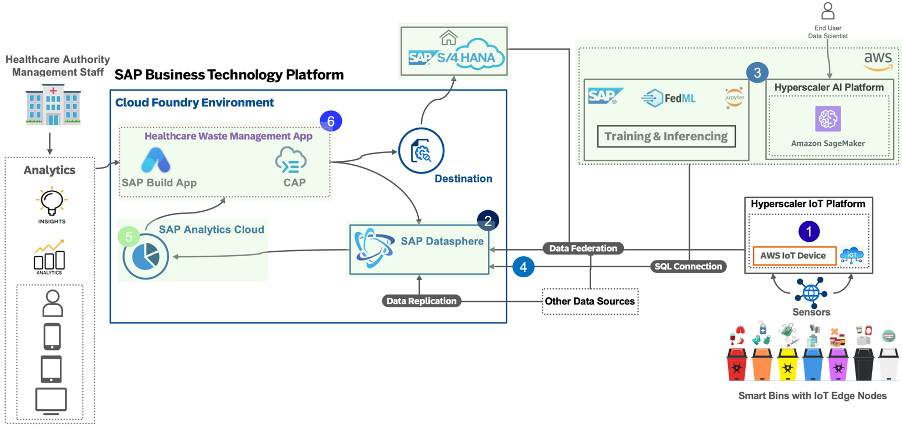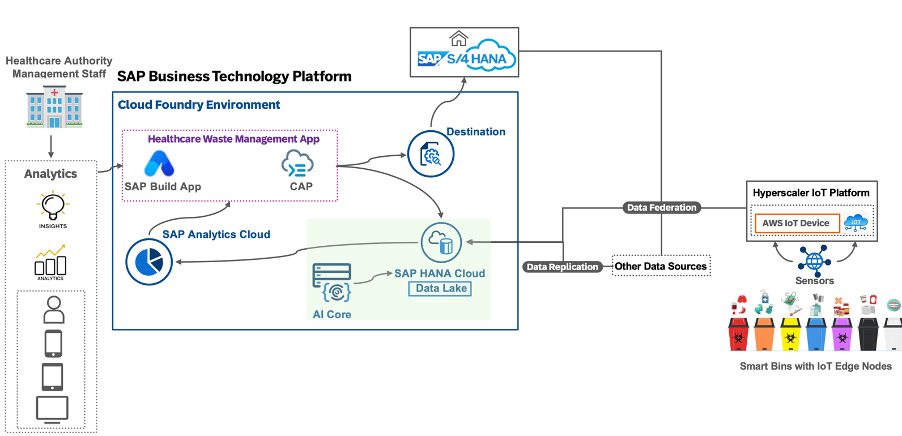
- SAP Community
- Products and Technology
- Technology
- Technology Blogs by SAP
- Deliver real-life use cases with SAP BTP - Sustain...
- Subscribe to RSS Feed
- Mark as New
- Mark as Read
- Bookmark
- Subscribe
- Printer Friendly Page
- Report Inappropriate Content
Please check the full calendar here to watch the recordings of all program sessions.
Authors: yatsea.li, thiago, mostafa.sharaf.
- Introduction
This blog post is closing the series of webinars we have started last February. We have been discussing for the whole year how SAP BTP can help you to develop and deliver valuable enterprise-grade solutions to your customers.
For each use case we cover the pain points and value proposition of the scenario in its target industry; we define a best-practice solution architecture based on SAP BTP; discuss the alternatives to that architecture and we show how to implement some of the key SAP BTP components in the proposed architecture.
During the journey we explore the key dimensions of an Intelligent and Sustainable Enterprise, and we hope that you get inspired to build similar scenarios for your customers.
Note: this is not a detailed training on the individual services used, but rather a suggested architecture based on the proposed use case.
- What is Healthcare Industry?
The healthcare industry is a complex and regulated field that has many different people and organizations involved, such as hospitals, clinics, research institutions, pharmaceutical companies, and medical device manufacturers.

They all work together to improve and promote the health and well-being of individuals and communities.
To achieve that goal, some points must be addressed.

These issues include the Patient Wait Times, Waste Management, Regulatory Compliance, Insurance and Billing issues, and operational costs control, which are within the most relevant ones.
I bring few key figures here to you just to set the stage for the waste management context we are going to work on: in healthcare facilities, 85% of the waste produced is considered General Waste while the other 15% is categorized as hazardous waste, which requires special attention due to the risks it poses for the community.
The cost of handling and treatment for both types of waste is different, so great separation plays a key role here.
In developed countries, hospitals generate, on average, 2.8 kilograms of general waste per hospital bed per day. This is a considerable volume of waste that could benefit from more sustainable practices.

Around 3% of the healthcare sector's total CO2 emissions can be directly attributed to waste management. This figure highlights an opportunity to address waste-related emissions.
A study by the "Health Care Without Harm" organization reveals that the healthcare industry contributes over 4% of global carbon dioxide (CO2) emissions. This is a significant environmental impact, considering healthcare's essential role in society.

To combat these environmental challenges, we must reduce waste, adopt efficient waste management practices, and integrate sustainable solutions into healthcare operations. By doing so, we can contribute to an eco-friendlier healthcare sector, where healing and environmental responsibility go hand in hand.
Our focus on waste management aligns with the broader mission to reduce the overall carbon footprint and create an eco-friendlier future. While seemingly a modest percentage (the waste treatment accounts for 3%) it holds immense significance.
Now that we know the opportunities we must improve in the sector, let’s get deep now on how the healthcare industry manages the waste.
Remember I said at the beginning that the healthcare industry is highly regulated? This is also true for how this waste should be collected, stored, transported, and disposed off safely.
They work with waste management companies that specialize in handling medical garbage. These companies have special trucks and equipment to pick up the waste and take it to designated facilities where it can be treated and destroyed in a way that doesn't harm people or the environment.
The solution we will design here will collect data from the stored waste, empowering health care industry companies with vital insights.

First, it will monitor and record greenhouse gas emissions, contributing to our commitment to environmental sustainability.
Second, it will record the weight of the waste, to optimize costs efficiently.
For this use case we assume the waste is already sorted correctly.
Let’s follow the journey of three key personas we have for this use case: Mary, our Facilities Expert; John, the Financial Analyst, and Bob, the Sustainability Analyst.

Let's start at the core of our operations - the Smart Bins. These bins, equipped with sensors, collect data on greenhouse gas emissions, and weight. When these bins reach their capacity, the data is ingested into SAP Datasphere, obviously through an IoT Platform.
Mary is going to use the App we will design to access the data from Datasphere. She reviews real-time information, selects the bins ready for disposal, and triggers a request for the third-party company to collect the selected bins. This will reflect in SAP S/4HANA Cloud in the form of a Purchase Order of service items.
Later, the cost data for that given transaction is posted back to Datasphere, enriching the data source for financial use.
That is just the transactional part of the story.
Now we will introduce a practical application of Federated Machine Learning. The historical data, both from S/4HANA Cloud and IoT devices will train a model, generating forecasts for costs, greenhouse gas emissions and weight.
These forecasts will find a purpose when integrated into SAP Analytics Cloud: they become dashboards for John and Bob. Through the App, our analysts access not only the past and current data, but also forecasts that will bring them insights to plan for the upcoming months, quarters, and years with precision.
Mary, John, and Bob are going to run the business with confidence, making informed decisions.
Let’s see a demo on the working prototype;
The S/4HANA Cloud, Smart Bins IoT, Datasphere, and management app work together seamlessly, creating a framework for the sustainability in the waste management sector of the healthcare industry.
- The Need for a Waste Management Solution
Right, so here is a summary of the features we are going to discuss how to implement.

We will see how to track both waste's weight, CO2 emissions and Costs, first to ensure financial effectiveness, second to reduce the healthcare sector's carbon footprint, and finally to enable companies to plan budgets wisely and streamline long-term sustainable operations.
- The Proposed Solution Architecture
So now we have gone the proposed solution features based on the use case’s business scenario requirements.

In this section, let’s explore here the architecture diagram of this proposed solution pertains to the healthcare waste management - use case:
- When a smart bin is full then an event for waste disposal with the relevant waste sustainability metrics (e.g. CO2 emissions & weight) will be triggered, such metrics are being measured & streamed live via IoT Devices attached to the dedicated smart bins at medical sites, that is all handled & managed via the Hyperscaler IoT Platform.
- Then Datasphere will ingest, federate & process all data coming across multiple data sources like:
- waste metrics aggregated data from the Hyperscaler IoT Platform via a pre-configured dataflow,
- other data from multiple data sources will be enriching more info to the triggered event such as the smart bins’ location, which medical entity, which department, category of the involved wastes, its treatment type, and other details about the handling treatment facility plus the waste disposal job order…etc. Such data will be coming from the corresponding backend systems of the involved medical entities, as well the engaged waste treatment facilities...etc.
- The FedML-AWS leverages DS federation architecture to automate the ML model training, building and deployment in Amazon Sagemaker while using only few lines of code and without the overhead of any data migration or replication towards the Hyperscalers. The target ML model will enable to predict waste related metrics.
- Once the trained forecasting ML model is inferenced, the output results will be imported into DS, which will carry the waste related metrics forecasting for next year.
- With the help of SAC, it will empower end-users with advanced analytical features which enable to interactively display healthcare waste metrics based on live data coming from SAP Datasphere - analytical models. SAC helps to visualize live the data to compare actual medical waste metrics vs waste metrics predictions using data coming in from the online IoT platform.
- Finally, SAP Build app will help to issue waste disposal orders in S/4HC in the form of PO as well as display the waste related metrics thru analytical dashboards (embedded from SAC). The app backend services are developed using CAP to handle business logic since integrating Build with CAP offers a powerful combination for developing feature-rich applications efficiently.
The highlighted BTP components as shown above, are the ones we have implemented as part of the PoC, which we will deep dive in the implementation section.
- Exploring the Possibilities
We would like to point out the main proposed architecture is not the only possible one to achieve our target solution for the healthcare waste footprint management, in fact there are several possibilities which you may leverage thanks to the powerful services in the SAP Business Technology Platform.
One possible alternative architecture – shown below, is to mainly leverage SAP Datasphere for data ingestion, federation from all engaged data sources as well for data modeling, while leveraging SAP HANA rich set of ML functions for prediction scenarios (for example thru PAL-Predictive Analysis Library & APL-Automated Predictive Library), whereby we can truly enable business data fabric architecture, equipped with ML embedded capabilities from the underlying SAP HANA Cloud Database.

Another alternative architecture – shown below, is to leverage SAP HANA Cloud & SAP HANA Data Lake for the data federation, in this use case scenario the data sources such as: S/4HC and IoT aggregated data coming from the Hyperscaler IoT Platform, plus the waste forecasting data through inferencing the trained ML model that’s deployed on SAP AI Core, as well data from other engaged data sources.
As for the SAP AI Core, it will take of the AI part, as it is designed to handle the execution & operations of your AI assets in a standardized, scalable, and Hyperscaler-agnostic way, supporting full lifecycle management of AI scenarios. So, in our scenario, AI Core will take care of building, training a prediction model for the waste metrics such as waste weights, relevant costs and related CO2 emissions as well deploying the trained model accordingly.

At Part2 in the next blog, we will deep dive into the implementation part to understand more in details how we built the prototype of the proposed healthcare waste management solution.
- Wrap-Up
To conclude, the proposed solution is a full stack app based on Build & CAP, which leverages FedML Lib to create an end-to-end automated solution for ML based scenarios.
- Useful References
- SAP Blog: Deliver real-life use cases with SAP BTP
- SAP Sustainability solutions
- SAP Healthcare
- SAP Business AI
- SAP Help Guide: SAP AI Core
- SAP Help Guide: Artificial Intelligence
- SAP Help Guide: SAP Build Apps
- SAP Help Guide: SAP Analytics Cloud
- SAP Help Guide: SAP Datasphere
- SAP Partners Community for Business Technology Platform
- SAP Community for Business Technology Platform
- SAP Business Technology Platform In Action
- Discovering SAP Business Technology Platform
- SAP Business Technology Platform Use Cases
- All SAP Learning Journeys
- SAP Developer Center
- SAP Discover Center
- SAP Managed Tags:
- Machine Learning,
- SAP Analytics Cloud,
- SAP Datasphere,
- Data and Analytics,
- Healthcare,
- Sustainability,
- SAP Build Apps
You must be a registered user to add a comment. If you've already registered, sign in. Otherwise, register and sign in.
-
ABAP CDS Views - CDC (Change Data Capture)
2 -
AI
1 -
Analyze Workload Data
1 -
BTP
1 -
Business and IT Integration
2 -
Business application stu
1 -
Business Technology Platform
1 -
Business Trends
1,658 -
Business Trends
106 -
CAP
1 -
cf
1 -
Cloud Foundry
1 -
Confluent
1 -
Customer COE Basics and Fundamentals
1 -
Customer COE Latest and Greatest
3 -
Customer Data Browser app
1 -
Data Analysis Tool
1 -
data migration
1 -
data transfer
1 -
Datasphere
2 -
Event Information
1,400 -
Event Information
70 -
Expert
1 -
Expert Insights
177 -
Expert Insights
339 -
General
1 -
Google cloud
1 -
Google Next'24
1 -
GraphQL
1 -
Kafka
1 -
Life at SAP
780 -
Life at SAP
14 -
Migrate your Data App
1 -
MTA
1 -
Network Performance Analysis
1 -
NodeJS
1 -
PDF
1 -
POC
1 -
Product Updates
4,575 -
Product Updates
382 -
Replication Flow
1 -
REST API
1 -
RisewithSAP
1 -
SAP BTP
1 -
SAP BTP Cloud Foundry
1 -
SAP Cloud ALM
1 -
SAP Cloud Application Programming Model
1 -
SAP Datasphere
2 -
SAP S4HANA Cloud
1 -
SAP S4HANA Migration Cockpit
1 -
Technology Updates
6,872 -
Technology Updates
470 -
Workload Fluctuations
1
- SAP Datasphere + SAP S/4HANA: Your Guide to Seamless Data Integration in Technology Blogs by SAP
- Unify your process and task mining insights: How SAP UEM by Knoa integrates with SAP Signavio in Technology Blogs by SAP
- 10+ ways to reshape your SAP landscape with SAP Business Technology Platform – Blog 4 in Technology Blogs by SAP
- Partner-2-Partner Collaboration in Manufacturing in Technology Blogs by SAP
- SAP Sustainability Footprint Management: Q1-24 Updates & Highlights in Technology Blogs by SAP
| User | Count |
|---|---|
| 17 | |
| 12 | |
| 11 | |
| 7 | |
| 7 | |
| 7 | |
| 7 | |
| 6 | |
| 6 | |
| 6 |